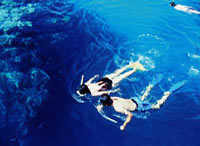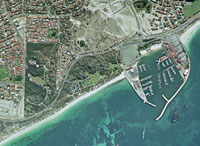|
Towards integrated management of
the region
Tourism is one of the many growing industries on the NWS.
Coastal development has accompanied the expansion of oil and gas production.
Under the United Nations Convention on the Law of the Sea, Australia is obliged to manage its 11-million square km Exclusive Economic Zone to conserve living and non-living resources in a sustainable manner. Achieving these goals on the North West Shelf is complicated by the rapid growth of marine industries and complex management and regulatory structures. A collaborative approach to integrated management that identifies the resources, habitat types and conservation values of ecosystems and involves stakeholders in decision-making, is essential to balancing these uses and avoiding conflict. One of the first industries to develop on the Shelf was South Seas Pearling, which sparked the first wave of immigrants to Australia’s north-west coast in the 1880s. They built the foundation for pearling – Australia’s richest aquaculture enterprise. Opportunities for new regional wealth emerged in the early 1960s, when the first commercial oils flowed from wells sunk on Barrow Island. Expanding oil and gas production has been accompanied by shipping and coastal development, commercial and recreational fishing and tourism. Each of these industries has its own management authority, and these operate under more than 200 separate federal, state and local government legislative requirements. They govern ports, maritime safety and pollution, quarantine and immigration, environmental protection and conservation, waste management, harvesting and licensing, recreational and indigenous fishing, vessel registration, tourism and fisheries management. A collaborative approach to integrated management that identifies the resources, habitat types and conservation values of ecosystems and involves stakeholders in decision-making, is essential to balancing these uses and avoiding conflict. |


